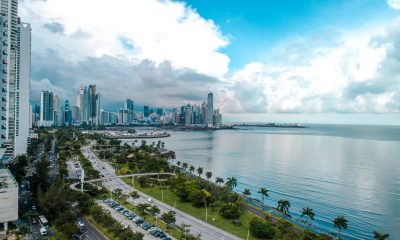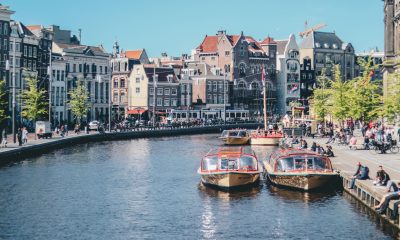Cannabis
EMCDDA: Dutch Cities Are Leaders in the European Drug Consumption Ranking
The latest EMCDDA research shows that the Netherlands still plays a key role in the European drug landscape, with standout cases such as Rotterdam and its dominance in cannabis use, and surprisingly high drug concentrations in Leeuwarden. These findings highlight the need for further research to understand why this is the case and to adapt policies and interventions to reduce the harmful effects.

A new report published by the European Monitoring Center for Drugs and Drug Addiction (EMCDDA) reveals the cities in Europe with the highest consumption of cannabis and cocaine, based on wastewater testing. It should come as no surprise that Dutch cities, including Amsterdam and Rotterdam, took the top spots for both substances, while also excelling in several other categories.
The study, conducted by a research team associated with the European Monitoring Center for Drugs and Drug Addiction (EMCDDA) in spring 2023, included the analysis of water in sewage treatment plants in 88 cities in 24 European countries. As part of the study, the concentration of six drugs in sewage per 1,000 inhabitants was checked. Researchers focused on methamphetamine, MDMA, cocaine, amphetamine, cannabis and ketamine.
Read more about the EMCDDA report on European drug consumption and find the most important cannabis news from around the world with the Hemp.im mobile app.
Results of the EMCDDA report
The latest EMCDDA report covering around 90 European cities reveals a mixed picture of drug use across locations. From Belgium to the Netherlands to Spain, we see significant differences in the intensity of cocaine, amphetamine, methamphetamine, MDMA, ketamine and cannabinoid use. The project, the largest of its kind in Europe, highlights the importance of wastewater analysis as a tool in monitoring drug use trends on a large scale.
Analysis of the most frequently detected substances in drug-related analyzes of municipal wastewater sheds light on the different trends and patterns of drug consumption in different parts of Europe. Below we provide detailed information about each of these substances:
Cocaine
Wastewater analysis has shown that the burden of benzoylecgonine (BE), the main metabolite of cocaine, is highest in cities in western and southern Europe. Particularly high levels were found in Belgium, the Netherlands and Spain, suggesting a strong presence and demand for cocaine in these regions. It is worth noting that despite lower consumption levels in Eastern European countries, the latest data shows a gradual increase. This trend may reflect changes in the availability of cocaine in Eastern European markets or the evolution of drug preferences in these communities.
Dope
The cannabis metabolite, THC-COOH, is detected in the highest concentrations in the sewage of cities in the Czech Republic, Spain, the Netherlands and Slovenia. These results suggest that cannabis consumption is particularly popular in these countries. The variation in consumption trends is interesting, with 20 cities reporting an increase in THC-COOH loads, which may indicate increasing social acceptance or increased availability of cannabis in these locations.
Amphetamine and Methamphetamine
Amphetamine concentrations in wastewater vary significantly depending on location, with the highest levels recorded in cities in northern and eastern Europe. This indicates that amphetamine remains a popular choice in these regions. Meanwhile, methamphetamine, although generally present in low concentrations, is showing increases in some Central European cities. This may indicate the expanding presence of methamphetamine outside traditional areas of consumption, such as the Czech Republic and Slovakia.
MDMA
MDMA, often associated with club culture and electronic music, has the highest concentrations in the sewage of cities in Belgium, France, Germany, the Netherlands and Spain.
Ketamine
Increases in ketamine concentrations in wastewater, especially in cities in Belgium, France, the Netherlands and Spain, highlight the growing popularity of this substance. Ketamine, originally used medically as an anesthetic, is gaining popularity in some social circles as a recreational substance, but it is also used for medical purposes.
It is most effective in the treatment of depression and some studies confirm that the effectiveness of ketamine in the treatment of depression is higher than that of traditional SSRI drugs. Its increasing concentration in sewage may indicate changes in risk perception and availability of this substance.
Drug consumption in Poland
The latest report by the European Monitoring Center for Drugs and Drug Addiction (EMCDDA) on drug consumption also includes data from Poland, specifically from Krakow. These data present an interesting picture regarding the consumption of various psychoactive substances. Based on the presented charts, several conclusions can be drawn regarding the trends and characteristics of drug consumption in recent years:
Cocaine
There is a noticeable increase in cocaine consumption over the years 2019–2022, with a slight decline in 2023. Interestingly, analysis of daily trends in 2023 reveals that the highest cocaine consumption occurs on weekends, with a peak on Saturday, suggesting the recreational nature of the drug’s use.
Cannabis
Cananbis consumption trends show an increase through 2021, followed by a stabilization with a slight decline in 2023. Daily trends in 2023 show that cannabis use is relatively consistent throughout most of the week except for Wednesday, when there is a decline.
Amphetamines
Amphetamine consumption shows an overall upward trend in 2017–2021, with a significant decline in 2022 and an increase again in 2023. The daily pattern in 2023 shows the highest consumption on Fridays and Saturdays, which may reflect increased amphetamine use during weekend nightlife.
Methamphetamine
Methamphetamine consumption shows a general increase since 2017, with the largest increase from 2022 to 2023. Daily trends show that Wednesday is the day with the highest consumption of this substance, which may suggest a difference in the nature of consumption compared to other days.
MDMA
MDMA consumption shows an increase until 2020, after which we observe slight fluctuations. In 2023, consumption is decreasing compared to the previous year, but is still at a high level. The daily trend in 2023 shows that the highest MDMA consumption occurs on weekends, which is typical for a substance associated with club culture.
Ketamine
Data on ketamine consumption shows an increase from 2022, which may indicate an increase in the popularity of the substance as a recreational drug. As with MDMA, ketamine is most commonly used on weekends, with lowest use during the middle of the week.
To sum up, the analysis of data from Krakow indicates various drug consumption patterns that may be related to various aspects of social and cultural life. The use of substances such as cocaine, MDMA and ketamine appears to be mainly associated with weekend activities, which may reflect the recreational nature of their consumption. In contrast, substances like amphetamines and cannabis are used more evenly throughout the week. A marked increase in methamphetamine consumption may signal a new trend in preferences for psychoactive substances in Poland.

The Netherlands at the forefront of European drug use: A detailed analysis
According to the latest study by the European Monitoring Center for Drugs and Drug Addiction (EMCDDA), Rotterdam has been hailed as the cannabis capital of Europe. The city recorded the highest concentrations of THC metabolites in wastewater of the 88 European cities surveyed, also ranking second for MDMA content. Cocaine is the most popular in Amsterdam, while drug use in Leeuwarden is astonishingly high, according to the NRC.
The Netherlands maintains a strong position in European drug use, with at least one Dutch city among the top five users of almost all drugs measured. The exception is methamphetamine, where none of the participating Dutch cities made it to the top ten.
Amsterdam, Leeuwarden and Rotterdam rank third to fifth in terms of cocaine use, after Antwerp and Tarragona. Rotterdam took first place for cannabis. Leeuwarden was third and Amsterdam fourth. Rotterdam (2), Amsterdam (3) and Utrecht (4) were in the top five for MDMA. Leeuwarden placed seventh.
Rotterdam (2) is the only Dutch city in the top five for ketamine use, although Leeuwarden (7) was in the top ten. Leeuwarden (5) is the only Dutch city in the top five for amphetamines. Rotterdam finished sixth. Amphetamine use in Leeuwarden is three times higher than in Amsterdam.
Eindhoven ranked seventh for cocaine use and Utrecht eighth. Both cities also ranked in the top 10 for cannabis use, in eighth and ninth place, respectively.
Conclusions of the EMCDDA report
The latest EMCDDA research shows that the Netherlands still plays a key role in the European drug landscape, with standout cases such as Rotterdam and its dominance in cannabis use, and surprisingly high drug concentrations in Leeuwarden. These findings highlight the need for further research to understand why this is the case and to adapt policies and interventions to reduce the harmful effects of drugs on communities.
__
(Featured image by audreysteenhaut via Pixabay)
DISCLAIMER: This article was written by a third party contributor and does not reflect the opinion of Born2Invest, its management, staff or its associates. Please review our disclaimer for more information.
This article may include forward-looking statements. These forward-looking statements generally are identified by the words “believe,” “project,” “estimate,” “become,” “plan,” “will,” and similar expressions. These forward-looking statements involve known and unknown risks as well as uncertainties, including those discussed in the following cautionary statements and elsewhere in this article and on this site. Although the Company may believe that its expectations are based on reasonable assumptions, the actual results that the Company may achieve may differ materially from any forward-looking statements, which reflect the opinions of the management of the Company only as of the date hereof. Additionally, please make sure to read these important disclosures.
First published in FaktyKonopne. A third-party contributor translated and adapted the articles from the originals. In case of discrepancy, the originals will prevail.
Although we made reasonable efforts to provide accurate translations, some parts may be incorrect. Born2Invest assumes no responsibility for errors, omissions or ambiguities in the translations provided on this website. Any person or entity relying on translated content does so at their own risk. Born2Invest is not responsible for losses caused by such reliance on the accuracy or reliability of translated information. If you wish to report an error or inaccuracy in the translation, we encourage you to contact us

-

 Crypto1 week ago
Crypto1 week agoAnalysts Warn Bitcoin’s Rally May Fade as MicroStrategy Signals Caution and Liquidity Weakens
-

 Cannabis6 days ago
Cannabis6 days agoUS Hemp Regulation Overhaul Sparks Global Impact
-

 Fintech2 weeks ago
Fintech2 weeks agoHashKey Holdings Secures HKEX Approval for IPO, Aiming to Raise $500 Million
-

 Crowdfunding3 days ago
Crowdfunding3 days agoDigital Finance Fosters Inclusivity: Women and Minorities Lead in Italian Equity Crowdfunding
























